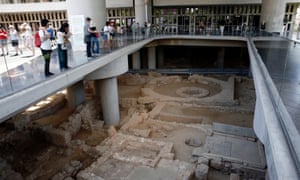Επιμέλεια: Ελένη Σοφού
Museum’s new exhibition space is an excavation site with villas, workshops and bathhouses
Helena Smith Athens
Museum’s new exhibition space is an excavation site with villas, workshops and bathhouses
Helena Smith Athens
The Parthenon on the Acropolis in Athens. Many of the marbles are on display at the museum. Photograph: Alamy Stock Photo
The pride – and purpose – of the Acropolis Museum has always been the Parthenon gallery. With its 360-degree panoramic view from the top floor, the museum has always been on a mission: to let the world know that this is the most appropriate place to exhibit the marbles that once adorned the Periclean masterpiece.
But a decade after it opened, the four-storey edifice at the foot of the Acropolis is now focusing on the lives of ancient Greeks. As the museum prepares to celebrate its 10th birthday on 20 June, it has announced the opening of a new exhibition space: an entire excavated neighbourhood of ancient villas, streets, workshops and bathhouses that lies below the museum building.
On Friday, as archaeologists put the finishing touches to the site, Dimitrios Pandermalis, the museum’s director, told how finds once considered a curse had become a blessing. “For the first time we are able to see how people lived in the shadow of the Acropolis,” he enthused, singling out an ornate ancient courtyard and a chamber where aristocrats had held symposiums.
“And through the display of discoveries such as plates and toys, visitors will have a glimpse into the daily lives of ancient Greeks. There are a lot of marble masterpieces on display around the museum but life is not only about the glory days of yesteryear; it is about little things that make each and every day.”
The excavation site, of villas and streets beneath the Acropolis Museum, is to open this month. Photograph: Alexandros Vlachos/EPA
The building of a €130m museum so close to the Acropolis, and on a site so rich in archaeology, was not without controversy. The discovery of ruins dating from the late classical era – in the fifth century BC – to the early Byzantine period in the 12th century AD delayed building work.
But the 13 years of digging paid off. One of the biggest excavations within the walls of ancient Athens helped archaeologists learn more than any previous dig had about the birthplace of democracy. “It was complex because there were so many layers, so many dwellings, one on top of the other, all telling the history of Athens,” said Stamatia Eleftheratou, who headed the excavation work.
The ancient settlement covers 4,000 square metres, accessed by steel walkways. But Eleftheratou and her team worked over an area three times that size, discovering close to 50,000 artefacts, including figurines of little-known deities. “There is an entire hidden layer, earlier ruins beneath the settlement that aren’t visible because we covered them again with earth,” she said.
Pandermalis said some of the treasures will also be on show in the exhibition space. A Roman-era copy of an original fourth century BC marble bust of Aristotle is likely to have pride of place when the artefacts go on display next year.
With its aquiline nose, protruding forehead and minute eyes and mouth, the bust is considered one of the best likenesses of the Greek philosopher. “He is well-groomed and well dressed,” smiled Pandermalis, saying the piece had been discovered by chance amid the debris of an archaeological trench.
“It is the image of a man who took great care of himself and that is fitting as we know, unlike other philosophers, Aristotle did indeed care about such things.”
Since you’re here…
… we have a small favour to ask. More people are reading and supporting our independent, investigative reporting than ever before. And unlike many news organisations, we have chosen an approach that allows us to keep our journalism accessible to all, regardless of where they live or what they can afford.
The Guardian is editorially independent, meaning we set our own agenda. Our journalism is free from commercial bias and not influenced by billionaire owners, politicians or shareholders. No one edits our editor. No one steers our opinion. This is important as it enables us to give a voice to those less heard, challenge the powerful and hold them to account. It’s what makes us different to so many others in the media, at a time when factual, honest reporting is critical.
Every contribution we receive from readers like you, big or small, goes directly into funding our journalism. This support enables us to keep working as we do – but we must maintain and build on it for every year to come. Support The Guardian from as little as €1 – and it only takes a minute. Thank you.
Πηγή: https://www.theguardian.com


Δεν υπάρχουν σχόλια:
Δημοσίευση σχολίου
Σημείωση: Μόνο ένα μέλος αυτού του ιστολογίου μπορεί να αναρτήσει σχόλιο.